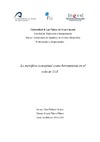Please use this identifier to cite or link to this item:
https://accedacris.ulpgc.es/jspui/handle/10553/70256
| DC Field | Value | Language |
|---|---|---|
| dc.contributor.advisor | Piñero Piñero, María de Gracia | - |
| dc.contributor.author | Palmero Suárez, Sara | - |
| dc.date.accessioned | 2020-02-12T17:35:02Z | - |
| dc.date.available | 2020-02-12T17:35:02Z | - |
| dc.date.issued | 2020 | en_US |
| dc.identifier.uri | https://accedacris.ulpgc.es/handle/10553/70256 | - |
| dc.description.abstract | pesar de que la metáfora, a lo largo de la historia, ha sido estudiada como un recurso principalmente retórico, destinado al embellecimiento del texto, nuestro trabajo parte de la concepción de la metáfora característica de la lingüística cognitiva, que la entiende como un procedimiento de categorización del significado propio del ser humano. Con estos presupuestos, el objetivo de nuestro trabajo será explorar las posibilidades que plantea el empleo de la metáfora conceptual en el aula de ELE, como herramienta adecuada tanto para la enseñanza y el aprendizaje de las diversas parcelas del español (la cultura, el léxico y la gramática), como para el desarrollo de la competencia metafórica del alumno. La introducción de esta competencia en el aula facilitará al estudiante el proceso de enseñanza-aprendizaje de la nueva lengua, ya que lo ayudará a comprender las diversas conexiones entre dominios que incorporan las expresiones metafóricas del español y, con ello, podrá elaborar un sistema conceptual que le permita entender y producir en la lengua nueva discursos con estructuras parecidas a las de un nativo. | en_US |
| dc.description.abstract | Although the metaphor has been studied throughout history mainly as a figure of speech which makes texts look more attractive, we have based our paper on the metaphor as a feature that belongs to cognitive linguistics. Thereby, it is understood as a process of categorization of meanings, common to all human beings. This project is aimed at exploring the different possibilities that the metaphor provides to teach Spanish as a foreign language: the metaphor as a tool which will help not only in the process of teaching and learning the Spanish culture, vocabulary and grammar, but also in the development of the metaphoric competence. Thus, the introduction of this competence will help students in the process of teaching and learning the new language; it will make them understand the different connections between domains, which lead to produce specific metaphorical expressions in Spanish. Therefore, the command of the metaphoric competence will enable learners to create a conceptual system, which will allow them to understand and produce texts like a native speaker in the new language. | en_US |
| dc.language | spa | en_US |
| dc.subject | 570111 Enseñanza de lenguas | en_US |
| dc.subject.other | Español lengua extranjera (ELE) | en_US |
| dc.title | La metáfora conceptual como herramienta en el aula de ELE | en_US |
| dc.type | info:eu-repo/semantics/bachelorThesis | en_US |
| dc.type | BachelorThesis | en_US |
| dc.contributor.facultad | Facultad de Traducción e Interpretación | en_US |
| dc.investigacion | Artes y Humanidades | en_US |
| dc.type2 | Trabajo final de grado | en_US |
| dc.utils.revision | Sí | en_US |
| dc.identifier.ulpgc | Sí | es |
| item.grantfulltext | restricted | - |
| item.fulltext | Con texto completo | - |
| crisitem.advisor.dept | GIR IATEXT: Cognición, Lingüística, Texto y Procesamiento de la Información | - |
| crisitem.advisor.dept | IU de Análisis y Aplicaciones Textuales | - |
| crisitem.advisor.dept | Departamento de Filología Hispánica, Clásica y de Estudios Árabes y Orientales | - |
| Appears in Collections: | Trabajo final de grado Restringido ULPGC | |
Page view(s)
375
checked on Jul 12, 2025
Download(s)
248
checked on Jul 12, 2025
Google ScholarTM
Check
Share
Export metadata
Items in accedaCRIS are protected by copyright, with all rights reserved, unless otherwise indicated.
